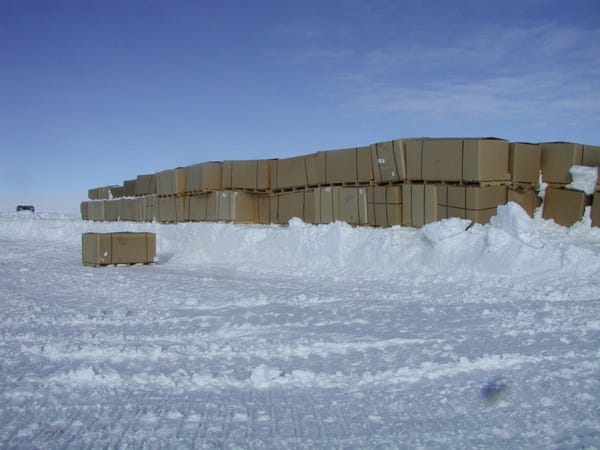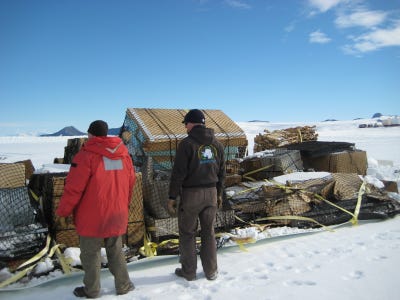Sanitation at the Bottom of the World
p.MsoNormal, li.MsoNormal, div.MsoNormal { margin: 0in 0in 0.0001pt; font-size: 12pt; font-family: "Times New Roman"; }div.Section1 { page: Section1; }The cold, hard truth about waste management in Antarctica.
December 2, 2011
By Carol Fey, Contributing Author
The continent of Antarctica is one of the most remote places on Earth. And on that continent at McMurdo Station, just 900 miles from the South Pole, you’ll find perhaps the most unique waste management department anywhere. It is 8,000 miles from Los Angeles, yet it processes, packages, documents and ships to California every piece of waste generated at two U.S. science bases in Antarctica. On top of this, it maintains an impressive 63 percent recycling rate.
A team of 15 seasonal workers sends 5.5 million pounds of solid waste and a million pounds of hazardous waste from Antarctica back to the United States in a single annual shipment. The department, whose members proudly call themselves “Wasties,” is part of the United States Antarctic Program (USAP), which supports the continent’s science investigations for the National Science Foundation (NSF). The waste department is managed by a staff of four headquartered in Denver.
 The waste department in Antarctica is like and yet unlike any other American trash and recycling center. Says department head Mark Furnish, “We have completely unique environmental and logistical challenges to deal with. There’s the cold, snow constantly re-arranged by the wind into new drifts, negotiating terrain with track vehicles, and when the weather warms up, there are dirt roads.”
The waste department in Antarctica is like and yet unlike any other American trash and recycling center. Says department head Mark Furnish, “We have completely unique environmental and logistical challenges to deal with. There’s the cold, snow constantly re-arranged by the wind into new drifts, negotiating terrain with track vehicles, and when the weather warms up, there are dirt roads.”
McMurdo Station sits on the coast of Antarctica, a five-hour flight from New Zealand by Air Force cargo plane, and operates like a small town. Its purpose is to support science, and that requires cooks, janitors, plumbers and, yes, “recycling technicians.”
A Culture of Recycling
“We don’t sort trash,” says supervisor James VanMatre. “For that we would need a crew triple the size of what we have. Our department processes and packages what the town has already sorted.”
How do you get a town of 1,200 people to sort 100 percent of their own trash? “It’s an installed, long-ongoing culture. It evolved over time,” explains VanMatre. “It started back in the 1990s. We constantly refine [the process] to make it easier. But the old-timers are proud of it, and they help enforce it.” VanMatre adds that “old-timers” refers to staffers that may have spent as many as 10 years at McMurdo.
“Most places, waste disposal is sort of invisible,” says VanMatre. But at USAP stations, trash sorting is front and center. Every building has a wall of small recycling cubicles from floor to ceiling. The main feature of every dormitory lounge is the colorfully painted recycling wall, with bins labeled to accept paper, plastic, glass, metal, food waste, cloth and non-recyclable material (“non-R”).
When a person arrives at McMurdo, a topic of orientation is how to sort your own trash and the importance of doing so. Where does tobacco chew go? In the food waste bin. What do you do with broken glass? Put it in a container, seal it and drop it in the “non-R” bin.
Occasionally, says VanMatre, a hardcore non-recycler steps off the plane grumbling, “I didn’t come all the way to Antarctica to sort trash.” VanMatre has a way of handling those folks: “An unsorted bag of trash is just a puzzle to be solved,” he says. “The janos (janitors) look through every piece, find the guy’s name in there somewhere, and hang the trash back on his dorm room door. He does it again, we go to his boss.”
VanMatre began his 13-year Antarctic career as a janitor himself. From there he became a waste technician, and then an equipment operator. “What better way could there be to learn to drive equipment,” he jokes. “You can’t damage the inventory.”
The station is a wonderland of neatly labeled Dumpsters: paper, light metal, heavy metal, wood. Trade departments such as plumbers and carpenters are responsible for sorting their waste into the containers. Construction projects must include waste plans. Industrial waste is also a big part of the department’s mission. Used telephone poles, lengths of pipe and scrap wood all must be processed.
The careful waste planning is crucial because all refuse must go into sea containers called mil-vans, and the mil-vans all have to fit onto the one annual ship. “This year we came within 10 sea containers of completely filling the ship with waste,” says Furnish, who notes that the ship also had to accommodate 50 cargo containers. “That was a close call.”
Each mil-van must have a two-year certification. The program owns around a thousand mil-vans: 500 throughout the station and 500 in transit.
Stuff That's Still Good
The department’s most senior member, at 24 years, is reuse/resale specialist Julie Richardson. Her job is to reclaim anything reusable, be it a box of bolts or a crane whose special project has been completed. “We aim to auction everything we can that is excess and obsolete,” says Richardson. “Our auction at Port Huenene, Calif., is a looked-forward-to annual event. For what we can’t reuse or auction, our third choice is to donate. Landfill is our last resort.”
The program maximizes the re-use of USAP property, thereby reducing waste, and alternatively providing a central system for resale, salvage or donation when reuse is not feasible.
Hazardous Waste
Another unique aspect of waste management in Antarctica is the high amount of hazardous waste, which makes up about 15 percent of the total waste produced. Furnish is the hazardous waste expert, and is certified in Environmental Protection Agency (EPA), Department of Transportation (DOT), Occupational Safety and Health Administration (OSHA), National Recycling Coalition (NRC), and International Maritime Dangerous Goods (IMDG) regulations. He has been with the USAP program for 17 years. A chemist with experience working with hazardous waste in the United States, he says, “Nothing prepares you for this job, though, except OJT (on the job training).”
Hazardous waste shipments from McMurdo total more than 40 sea containers a year.
Why so much? “We have the same problem as every university that has large high tech labs,” says Furnish. “A scientist uses half a bottle of a chemical, and the rest becomes hazardous waste.” This is compounded, he says, by the fact that scientists from many different universities work in Antarctica, including in labs in remote field camps.
 Science Field Camps
Science Field Camps

Science teams come through McMurdo Station on their way to remote field work. Field camps present a special waste management challenge. In addition to solid and hazardous waste, liquids such as gray water and urine must be flown or traversed out overland. Frozen barrels are transported back to McMurdo, where they are stored and staged for annual transport by ship back to the United States.
Spill Management
A unique aspect of the waste team is that they are a trained spill response team. The International Antarctic Treaty requires that any outdoor spill, no matter how small, must be cleaned up. With up to 1,200 people at the station during the summer season, and with numerous science teams out on the ice, there are 15 to 20 spills monthly that require remediation.
“Every drop requires that we fill out a form and document,” says Furnish.
Documentation and Reporting
Indeed, precise documentation and reporting is a big part of the department’s overall mission. The department employs Steve Kupecz, the regulatory data management specialist, to gather data and create the reports. There are reporting requirements for international entities and for the Antarctica Conservation Act.
Documentation must be provided to detail spills, substances released into the atmosphere, pounds of waste and the amount of hazardous waste. The waste department knows exactly how much it recycles because it keeps precise records of the waste it processes, packages and ships back to the United States.
Back at the Waste Barn
Although the station sorts its own trash, the waste department opens almost every bag to identify unsorted waste and also to check for any hazardous waste items incorrectly sorted. The department is proud to earn top dollar from Bellingham, Wash.-based Best Recycling, which accepts its material. Like-material trash is then packaged into enclosed containers, labeled, weighed and stacked outside to await once-a-year shipment back to the United States.
Once the annual supply vessel arrives in February and new supplies are off-loaded, it is time for the Wasties to kick into high gear. For two weeks they work around the clock to load the ship with all the waste created that year: solid, liquid, hazardous, frozen food waste, and even dried processed sewage called “cake.”
The Hold of the Cold
There’s no debate: Life in Antarctica is hard labor in often-harsh conditions. Everyone works nine hours a day, six days a week, and lives doubled up in dormitories. But people go back season after season, year after year. Second-year Wastie Kate Fey explains why anyone would travel that distance to process trash: “We work super-hard, but our management creates a culture of fun. I love these people, and we all believe that recycling is important.”
Carol Fey has worked in Antarctica for two seasons as a heating mechanic and as an emergency communications operator. You can reach her at [email protected].
The United States Antarctic Program is managed by the National Science Foundation. To learn more about this program go to www.usap.gov.
Ten Safety Tips from the Wasties at McMurdo Station
Safety first — It’s just trash.
Fire, surprisingly, is the greatest danger in Antarctica. With strong winds and closely arranged buildings, the risk of a fire spreading is high. The resulting loss of shelter in that harsh environment would be devastating.
Weather can change very fast with a temperature drop, wind, and loss of visibility from blowing snow or fog.
Wear the right clothes, and don’t get wet. Wind chill can be deadly.
Frostbite can happen before you know it. Keep your nose and ears covered.
Learn to work with your gloves on.
Stretch often. You are not as flexible in the cold as in warm weather.
Beware of sunburn. Even though the temperature is low, the Sun’s rays are intense, including reflected off the ice. And in summer, the sun shines around the clock.
Watch out for rocks to avoid a twisted ankle. Some parts of Antarctica are dry ground, which exposes rock debris.
You are in charge of your own safety. Serious medical help is far away.
McMurdo Station Info
McMurdo Station constitutes the largest community in Antarctica. In addition to scientific facilities and 10 dormitories, McMurdo’s more than 100 buildings house three bars, a chapel, a fitness center, a barbershop, a medical center, water, power and sewer plants, a library and the continent’s only automated teller machine. More than 1,000 people live there during the southern hemisphere (austral) summer from October through February, many of them scientists on their way to field camps farther inland. There are also hundreds of staffers who keep the town running, including cooks, plumbers, janitors and fire techs. The population shrinks to fewer than 200 “winter-overs” who maintain the facility during the dark months of March through August.
You May Also Like


